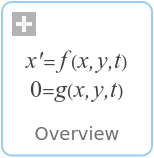WOLFRAM SYSTEM MODELER
OverviewOverview |
|
Wolfram Language

SystemModel["Modelica.Fluid.UsersGuide.Overview"]

Information
This information is part of the Modelica Standard Library maintained by the Modelica Association.
The Modelica.Fluid library provides basic interfaces and components to model 1-dimensional thermo-fluid flow in networks of pipes. It is not the intention that this library covers all application cases because the fluid flow area is too large and because for special applications it is possible to implement libraries with simpler component interfaces. Instead, the goal is that the Modelica.Fluid library provides a reasonable set of components and that it demonstrates how to implement components of a fluid flow library in Modelica, in particular to cope with difficult issues such as connector design, reversing flow and initialization.
This library has the following main features:
- The connectors Modelica.Fluid.Interfaces.FluidPort_a/_b are designed
for one-dimensional flow of a single substance
or of a mixture of substances with optional multiple phases.
All media models from Modelica.Media can be utilized when
connecting components. For one substance media, the additional arrays for
multiple
substance media have zero dimension and are therefore removed
from the code during translation. The general connector definition
therefore does not introduce an overhead for special cases.
- All the components of the Modelica.Fluid library are designed
that they can be utilized for all media models from
Modelica.Media if this is possible. For example, all media can
be utilized for the Modelica.Fluid.Sensors/Sources components.
For some components only special media are possible, since additional
functionality is required. For example,
Modelica.Fluid.Components.Evaporator requires a two phase medium
(extending from Modelica.Media.Interfaces.PartialTwoPhaseMedium).
- In order to simplify the initialization in the components,
there is the restriction that only media models are supported
that have T, (p,T), (p,h), (T,X), (p,T,X) or (p,h,X) as
independent variables. Other media models would be possible,
e.g., with (T,d) as independent variables. However, this requires
to rewrite the code for the component initialization.
(Note, T is temperature, p is pressure, d is density,
h is specific enthalpy, and X is a mass fraction vector).
- All components work for incompressible and compressible media.
This is implemented by a small change in the initialization of a
component, if the medium is incompressible. Otherwise, the equations
of the components are not influenced by this property.
- All components allow fluid flow in both directions, i.e.,
reversing flow is supported. However, it is possible to declare that
the flow through a component only has the design direction, in order to
obtain faster simulation code.
- Two or more components can be connected together. This means that
the pressures of all connected ports are equal and the mass flow rates
sum up to zero. Specific enthalpy, mass fractions and trace substances are
mixed according to the mass flow rates.
- The momentum balance and the energy balance are only fulfilled exactly if
two ports of equal diameter are connected. In all other cases, the balances
are approximated, because kinetic and friction effect are neglected. An explicit fitting
or junction should be used if these are important for the specific problem at hand.
In all circuits where friction dominates, or components such as pumps determine the flow rate,
kinetic pressure is typically irrelevant. You can consider the
Modelica.Fluid.Examples.Explanatory.MomentumBalanceFittings model (and its documentation)
to see one case where the momentum balance essentially depends on kinetic pressure,
so it is necessary to use explicit fittings in order to obtain correct results.
- Given the above-mentioned limitations, there is no restriction how components can be connected
together. The resulting simulation performance however often strongly depends on the
model structure and modeling assumptions made. In particular the direct connection of
fluid volumes generally results in high-index DAEs for the pressures. The direct
connection of flow models generally results in systems of implicit nonlinear algebraic
equations.
